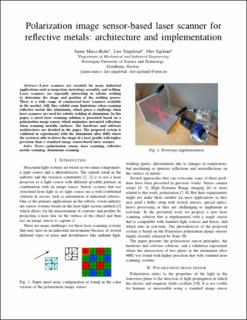| dc.contributor.author | Marco Rider, Jaime | |
| dc.contributor.author | Tingelstad, Lars | |
| dc.contributor.author | Egeland, Olav | |
| dc.date.accessioned | 2022-06-29T06:52:29Z | |
| dc.date.available | 2022-06-29T06:52:29Z | |
| dc.date.created | 2022-01-13T08:48:05Z | |
| dc.date.issued | 2021 | |
| dc.identifier.issn | 1930-0395 | |
| dc.identifier.uri | https://hdl.handle.net/11250/3001438 | |
| dc.description.abstract | Laser scanners are essential for many industrial applications such as inspection, metrology, assembly, and welding. Laser scanners are especially interesting in robotic welding to determine the shape and position of the welding groove. There is a wide range of commercial laser scanners available in the market, still, they exhibit some limitations when scanning reflective metals like aluminium, which poses a challenge when laser scanners are used for robotic welding of aluminium. In this paper, a novel laser scanning solution is presented based on a polarization image sensor, which minimizes unwanted reflections when scanning metallic surfaces. The hardware and software architectures are detailed in the paper. The proposed system is validated in experiments with the aluminium alloy 6082 where the system is able to detect the shape of a laser profile with higher precision than a standard image sensor-based laser scanner. | en_US |
| dc.language.iso | eng | en_US |
| dc.publisher | Institute of Electrical and Electronics Engineers (IEEE) | en_US |
| dc.title | Polarization image sensor-based laser scanner for reflective metals: architecture and implementation | en_US |
| dc.type | Peer reviewed | en_US |
| dc.type | Journal article | en_US |
| dc.description.version | acceptedVersion | en_US |
| dc.rights.holder | © IEEE. Personal use of this material is permitted. Permission from IEEE must be obtained for all other uses, in any current or future media, including reprinting/republishing this material for advertising or promotional purposes, creating new collective works, for resale or redistribution to servers or lists, or reuse of any copyrighted component of this work in other works. | en_US |
| dc.source.journal | Proceedings of IEEE Sensors | en_US |
| dc.identifier.doi | 10.1109/SENSORS47087.2021.9639607 | |
| dc.identifier.cristin | 1980064 | |
| dc.relation.project | Norges forskningsråd: 295138 | en_US |
| cristin.ispublished | true | |
| cristin.fulltext | postprint | |
| cristin.qualitycode | 1 | |
